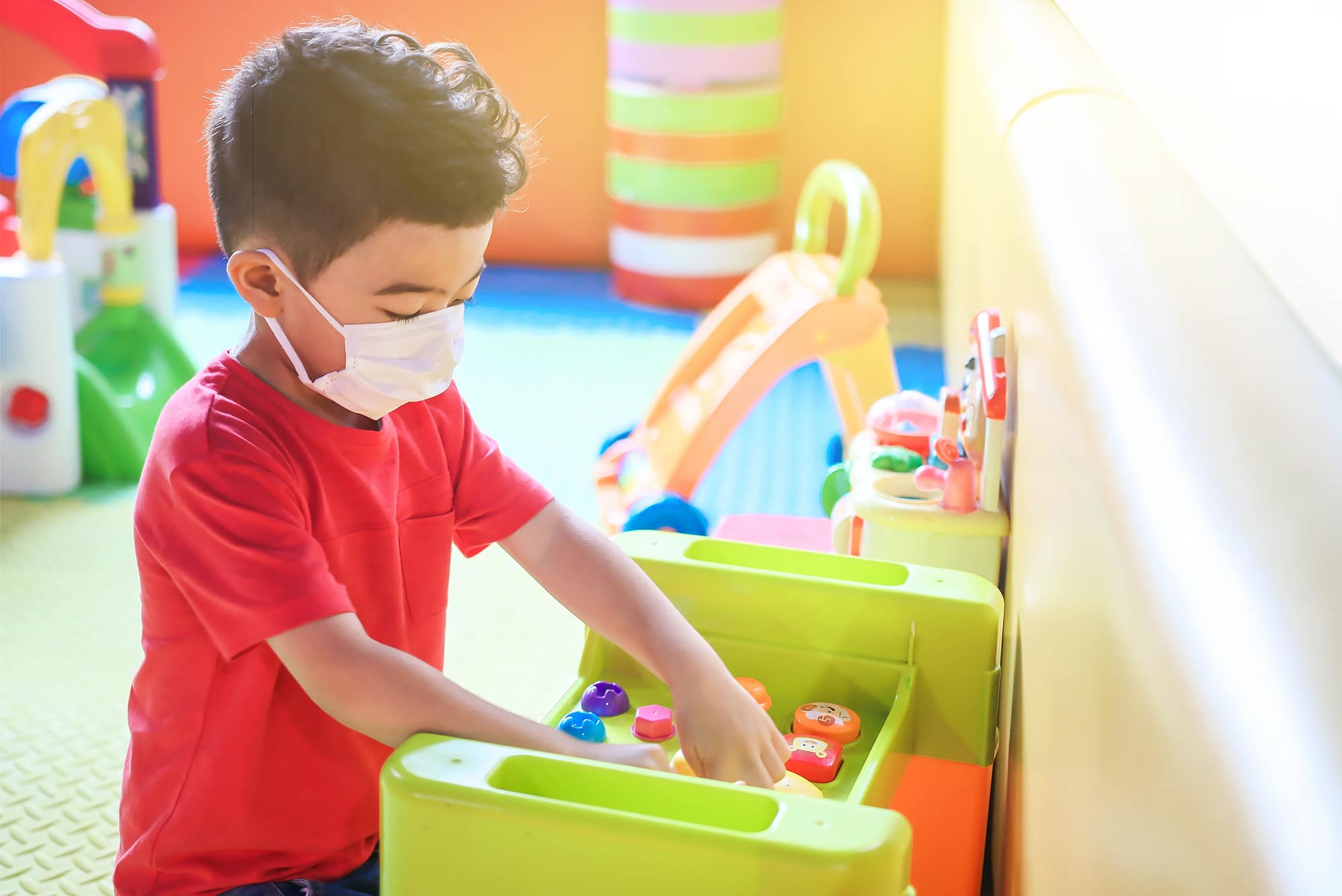Navigating Autism Through the COVID Pandemic
Written By: Gina Ballone, MS, BCBA

As we all adjust our daily routines due to the pandemic, it sometimes can be more challenging when you have a child who struggles with change. After all, just think about the numerous changes that children had to endure at the very start of COVID . . . change from in-person to virtual school, lack of consistency with their regular activity schedule, changes to daily activities, having to wear a mask, etc. The list goes on, and we need to be mindful of how challenging some of these changes can be to children with various backgrounds.
When I speak to many parents about their concerns throughout the pandemic, the most prevalent answer seems to be tolerating wearing a mask. This article will address this area to provide some general strategies and suggestions, along with an analysis of how you can determine why the mask is non-preferred.
Tolerating Wearing a Mask
Wearing a mask helps prevent the spread of Covid-19, therefore it is important to teach all children to tolerate wearing a mask (if medically appropriate and no breathing issues are evident). With any resistance towards wearing a mask, it’s essential to first determine why it’s un-preferred. This initial analysis is so important because it will assist in setting up some proactive strategies. Here are some examples that should be analyzed before running a program to tolerate the mask:
- Are the straps too tight?
- Some children with various sensory sensitivities might be uncomfortable with how fitted the mask is to their face; Some children might have sensitivities of having something pulled against the back of their ears. Sometimes you might have to adjust the tightness and allow the straps to be a bit looser to get the right fit. Also, some straps have softer material, so make sure you don’t have straps that are rough/itchy/uncomfortable. There are also face mask extenders and ear savers that can be found online. These put the pressure on the back of the head (just like straps for eyeglasses), rather than the back of the ears.
- Are the straps too loose?
- Sensory systems are all unique. It could be a possibility that your child might be frustrated with how loose the straps are, so make sure you have the right fit.
- Does the fabric have an unpleasant scent?
- Just think how powerful the sense of smell is when your child’s nose is so close to the actual mask material. For those children who have a super-charged sense of smell, this is a very important thing to consider when choosing the right mask. For example, I had a client inform me that his mask (purchased from a well-known department store), smelled like cardboard and it was making him feel sick. This was a wonderful example of a child being able to self-advocate, but what about children that don’t have a robust set of language skills to do this? We need to be the “detectives” and “smell” for ourselves with the masks that we are providing. Also, be careful on the laundry detergent or fabric softener that you use. This might not have been an issue in the past, but when you really analyze a mask, and the fact that it’s so close to the nose, then it’s not the same playing field as a shirt or pants.
- Is the fabric itchy/uncomfortable?
- I myself have experienced some itchy masks and immediately was turned off. Just as above, “experience” the mask for yourself and determine which textures/materials that your child finds pleasant.
- Does your child have breathing difficulties?
- Up until now, you might not have even known that your child could possibly have some breathing difficulties because before the pandemic how often did your child have to wear a mask? However, take this concern seriously and if you observe heavy breathing, panting or any other serious indicators, I suggest consulting with your doctor and your child might be exempt from wearing a mask and other alternatives such as a face shield might be recommended
Now that we have done the analysis and have secured the proper mask, let’s dive into how we can promote wearing it in the most positive and compassionate way. Here are some general strategies based on the principles of ABA to assist in increasing tolerance towards wearing a mask. We encourage you to consult with a BCBA for a formal behavior plan. Therefore, please use the following information only as a general guide that can be modified and individualized for your child!
Pair the Mask with Positive Reinforcement:
- Present the mask to your child while delivering positive reinforcement such as:
- Social praise
- Highly preferred items (e.g., edibles, toys)
- Highly preferred activities (e.g., swinging, coloring)
- Adult attention (e.g., singing, air high fives)
Using Shaping to get acclimated
- Here are some examples of shaping (“Shaping” involves reinforcing successive approximations/steps to reach the bigger goal which is being able to wear the mask)
- Touches any part of the mask
- Holds the mask
- Brings the mask up to their face
- You can hold the mask up to their face while providing reinforcement. This will allow your child to get used to having something in front of their nose and mouth, but without actually wearing the mask.
- Allows the mask to be put on and immediately removed
- Allows mask to be worn for a few seconds
- Allows mask to be worn for a few minutes
- Allows mask to be worn for half an hour
- Allows mask to be worn for an hour
In order to shape the behavior of wearing a mask, you can contrive trials with very short intervals at first and then increase interval lengths in order to increase the tolerance or duration of wearing the mask. At the beginning, we reinforce all attempts consistently and frequently! As we gradually reach the target behavior (i.e., wearing the mask for “X” amount of time, we will slowly thin the schedule of reinforcement). Where we begin shaping procedures depends on the current level of your child’s ability to wear a mask (i.e., baseline). For example, some children can wear a mask for 5 minutes, while others not even 5 seconds. Some children are visual learners; therefore, it may be useful to use a visual timer or a visual schedule.
Provide Differential Reinforcement!
Once your child can have the mask on their face without you having to hold the mask up, it’s important to provide better reinforcement (we call this differential reinforcement). In other words, we want to provide bigger and better rewards for the appropriate response (having the mask fully on the face independently).
New behaviors and routines take time so don’t give up! The following link is a great resource (Wear a mask song for kids) that is a fun video to show your child if they like music/videos!
Disclaimer: The above guidelines are only general tips. We highly encourage you to consult with a BCBA for a formal behavior plan if needed.
Date Posted:
February 15, 2022
Share this blog
Categories
Recent Blog Posts








